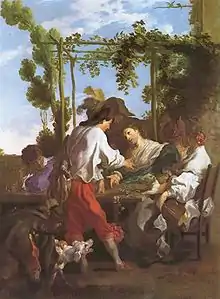Johann Liss
Johann Liss (also called Jan Lys) (c. 1590 or 1597 - 1629 or 1630) was a leading German Baroque painter of the 17th century, active mainly in Venice.


Biography
Liss was born in Oldenburg (Holstein) in Schleswig-Holstein, Germany. After an initial education in his home state, he continued his studies, according to Houbraken, with Hendrick Goltzius in Haarlem and Amsterdam. Around 1620 he travelled through Paris to Venice. He moved to Rome around 1620–1622, and his first works there were influenced by the style of Caravaggio.
Although his earlier work was concerned with the contrasts of light and shadow, his final move to Venice in the early 1620s modified his style and gave impetus to brilliant color and a spirited treatment of the painted surface. In 1627, he was created an admired large altarpiece, the Inspiration of Saint Jerome in San Nicolò da Tolentino. His loose brushstrokes seem precursor to rococo styles of Guardi brothers. This final style, along with that of other "foreign" painters residing in Venice, Domenico Fetti and Bernardo Strozzi, represent the first inroads of Baroque style into the republic.
Liss fled to Verona to escape the plague spreading in Venice, but succumbed there prematurely in 1629. According to Houbraken, he worked day and night on his paintings, so that Joachim von Sandrart felt that his health was at risk and urged him to join him in Rome.[1]
His legacy is as a painter of both sensuous mythological and pious biblical subjects, a master of colors and Baroque painting. He was most influential to Venetian 18th-century painters like Sebastiano Ricci, Giovanni Battista Tiepolo and Giovanni Piazzetta.
Joachim von Sandrart wrote in 1675 that "because he fared well in Venice, he soon returned there ... he died along with many others during the plague that began in 1629."[2]
Examples of work
- Lute Player
- Visitation of St Jerome
- Vision of Saint Jerome[3]
- Peasants playing mora
- Judith in the Tent of Holofernes {c.1622, National Gallery, London)
- Death of Cleopatra[4]
- Abel mourned by his parents[5]
- Venus in front of mirror (1625–26, Uffizi)[6]
- Death of Phaeton[7]
- Cupid (Cleveland Art Museum, Cleveland, Ohio)
References
| Wikimedia Commons has media related to Johann Liss. |
- Jan Lis biography in De groote schouburgh der Nederlantsche konstschilders en schilderessen (1718) by Arnold Houbraken, courtesy of the Digital library for Dutch literature
- Spear, Richard E. (December 1976). "Johann Liss Reconsidered". The Art Bulletin. 58 (4): 582–593. doi:10.2307/3049572. JSTOR 3049572.
- "The Death of Cleopatra by Liss, Johann". Wga.hu. Retrieved 2013-07-23.
- "Adam and Eve Mourning for Abel by LISS, Johann". Wga.hu. Retrieved 2013-07-23.
- "Venus in front of the Mirror by Liss, Johann". Wga.hu. Retrieved 2013-07-23.
- Wittkower, Rudolf (1993). "ch. 5". Pelican History of Art, Art and Architecture Italy, 1600-1750. 1980. Penguin Books Ltd. pp. 106–7.
